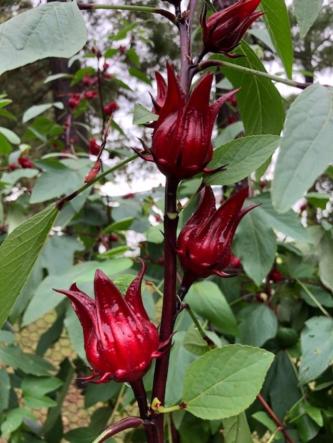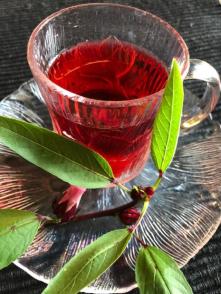By Maryann Readal
With its bright red calyces, green leaves, and okra-like flowers, Hibiscus sabdariffa, also known as red zinger, red sorrel, sour tea, Florida cranberry, and roselle, makes an unusual and striking accent plant in the garden. On a recent trip to Montreal, I was surprised to see red zinger hibiscus growing at the back of formal garden borders. I thought it was a plant that grew only in tropical and sub-tropical climates. Apparently, it does well in cooler climates as well. We don’t normally think of red zinger hibiscus as a landscape plant, but indeed it can be.
known as red zinger, red sorrel, sour tea, Florida cranberry, and roselle, makes an unusual and striking accent plant in the garden. On a recent trip to Montreal, I was surprised to see red zinger hibiscus growing at the back of formal garden borders. I thought it was a plant that grew only in tropical and sub-tropical climates. Apparently, it does well in cooler climates as well. We don’t normally think of red zinger hibiscus as a landscape plant, but indeed it can be.
And of course, an interesting side note to this hibiscus is that the whole plant has many uses. The red calyces surrounding the seed can be removed and dried and used to make a refreshing hot or cold tea. The fresh calyces can be chopped and used in fruit salads. They can also be cooked, and the resulting sauce is similar to cranberry sauce. If making jelly from the sauce, pectin does not need to be added as roselle calyces contain 3% pectin. Go The Herb Society’s Herb of the Month web page for recipes using roselle. The leaves and tender shoots can be tossed in salads. In many countries the leaves are eaten as a vegetable and  as a meat accompaniment. The seeds can be pressed for oil, and the mash left over from processing can be fed to livestock. Chickens enjoy the seeds. The seeds can also be roasted and used as a coffee substitute. The fiber in the stems can be processed into rope or into rough cloth such as burlap. It is truly a plant with many uses.
as a meat accompaniment. The seeds can be pressed for oil, and the mash left over from processing can be fed to livestock. Chickens enjoy the seeds. The seeds can also be roasted and used as a coffee substitute. The fiber in the stems can be processed into rope or into rough cloth such as burlap. It is truly a plant with many uses.
 Hibiscus tea has several health benefits including lowering blood pressure, which has been documented in clinical trials. It can be made into a drink that helps to cool the body, making it a very common beverage in hot, tropical climates. In Africa, India, and Mexico, the flowers, leaves, calyces and stems of the plant are used in native medicine. In some countries, the root is also used for medicine.
Hibiscus tea has several health benefits including lowering blood pressure, which has been documented in clinical trials. It can be made into a drink that helps to cool the body, making it a very common beverage in hot, tropical climates. In Africa, India, and Mexico, the flowers, leaves, calyces and stems of the plant are used in native medicine. In some countries, the root is also used for medicine.
This plant is native to North Africa and Southeast Asia. It is thought that Africans brought the seeds to the New World. It has naturalized in the West Indies and Central America. It is interesting that USAID is now supporting rural farmers, mostly women, to grow this hibiscus in West Africa.
If you plan to grow Hibiscus sabdariffa in your garden, be prepared to give it plenty of sun, water, and a lot of room to grow. It can easily reach seven feet tall and six feet wide. Pruning it early in the spring will encourage branching. Roselle will not tolerate frost, making it an annual in all but tropical climates. It does not bloom until the days are short, usually in October. Some say that the calyces should not be harvested until 10 days after the okra-like blossoms drop off. Leaving the calyx on longer will result in a brown, woody seed pod.
Whatever you call it or whatever you use it for, roselle is an interesting herb to know about. I like this plant!
Herb Society of America Medical Disclaimer … It is the policy of The Herb Society of America not to advise or recommend herbs for medicinal or health use. This information is intended for educational purposes only and should not be considered as a recommendation or an endorsement of any medical or health treatment.


Pingback: Christmas Herbs of Trinidad, Part I – The Herb Society of America Blog
Pingback: La’au Lapa’au | Roselle Hibiscus– An Herb with Many Names – Hālau 'Aha Hūi Lanakila™
Reblogged this on Crooked Bear Creek Organic Herbs.
LikeLike
Where do you suggest that we could obtain the seeds?
LikeLike
You can buy them on Amazon.
LikeLike
Maryann – Great post! Thanks for reminding us northerners that we can grow this herb. It will definitely be on my list next summer.
LikeLike
If it grows in Canada, surely it will grow in the Cleveland area.
LikeLike
Pingback: Roselle Hibiscus– An Herb with Many Names – Human Health
Pingback: Roselle Hibiscus– An Herb with Many Names – The Herb Society of America Blog - Healthybeautyherbs.com